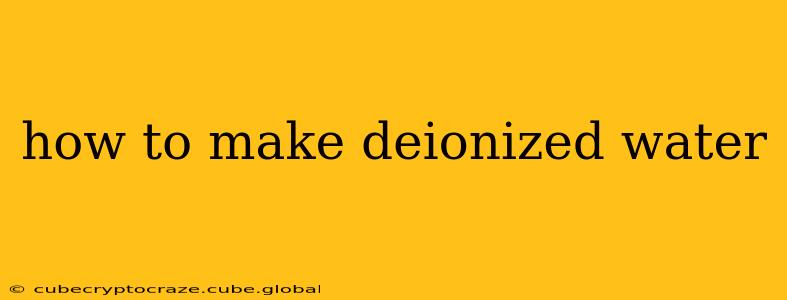Deionized water, also known as demineralized water or pure water, is water that has had almost all of its mineral ions removed. This process, called deionization, is crucial in various applications, from scientific research and industrial processes to car batteries and even steam irons. But how is it made? Let's delve into the different methods and explore the intricacies of this vital purification process.
What is Deionization?
Before we dive into how to make deionized water, it's crucial to understand what deionization is. It's a water purification process that uses ion-exchange resins to remove dissolved ions, such as minerals, salts, and other impurities. These resins are typically made of synthetic polymers containing charged functional groups that attract and bind oppositely charged ions in the water. This leaves behind water with very low conductivity, indicating a significantly reduced concentration of dissolved ions.
Methods for Making Deionized Water
While you can't easily make deionized water at home with the same level of purity as commercial systems, understanding the industrial methods offers valuable insight. The most common methods include:
1. Ion Exchange Resins: The Heart of Deionization
This is the primary method used in commercial deionization systems. The process involves passing water through a bed of ion-exchange resins contained in a column. These resins consist of two types:
- Cation exchange resins: These resins contain negatively charged functional groups that attract and bind positively charged ions (cations) like calcium, magnesium, and sodium.
- Anion exchange resins: These resins contain positively charged functional groups that attract and bind negatively charged ions (anions) like chloride, sulfate, and nitrate.
The water passes through both resin beds, effectively removing most dissolved ions.
2. Electrodialysis: Using Electricity for Purification
Electrodialysis uses an electric field to separate ions from the water. A membrane separates the water into compartments, and an electric current forces the ions to migrate through the membrane, leaving behind purified water.
3. Reverse Osmosis: A Multi-Stage Approach
While not strictly deionization, reverse osmosis (RO) significantly reduces the concentration of dissolved ions. RO systems use pressure to force water through a semi-permeable membrane, leaving behind most impurities, including ions. RO often acts as a pre-treatment step before ion exchange for even purer water.
How to Get Deionized Water (Without Building a Lab)
Creating truly deionized water at home requires specialized equipment not typically available to the average person. However, you can purchase deionized water relatively inexpensively from various sources:
- Chemical supply stores: These stores often sell deionized water in bulk or smaller containers.
- Pharmacies: Some pharmacies may carry deionized water, especially if they handle laboratory equipment.
- Online retailers: Numerous online retailers sell pre-packaged deionized water.
Frequently Asked Questions (FAQ)
What is the difference between distilled water and deionized water?
Distilled water removes impurities through boiling and condensation, leaving behind many dissolved solids. Deionized water goes further, using ion exchange to remove almost all dissolved ions, resulting in purer water with a much lower conductivity.
What are the applications of deionized water?
Deionized water has numerous applications, including:
- Laboratory work: Essential in various experiments and analytical procedures where dissolved ions can interfere.
- Automotive batteries: Helps prevent corrosion and maintains battery performance.
- Steam irons: Prevents mineral buildup and extends the lifespan of the iron.
- Industrial processes: Used in various industrial processes where pure water is crucial.
Can I reuse deionized water?
Once deionized water is exposed to the atmosphere, it will start to re-absorb ions. Therefore, reusing deionized water is generally not recommended, especially for applications requiring high purity.
How long does deionized water remain pure?
The purity of deionized water degrades over time, especially if exposed to air. Storage in a sealed container can help prolong its purity.
By understanding the process of deionization and the readily available options for obtaining deionized water, you can make informed decisions based on your specific needs and applications. Remember, while creating high-purity deionized water at home is impractical, accessing it is readily achievable through various commercial sources.
